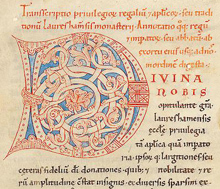The Codex Laureshamensis
The so-called Lorsch Codex (lat. Codex Laureshamensis), which is now kept in the Staatsarchiv Würzburg under the shelfmark "Mainzer Bücher verschiedenen Inhalts 72", is one of the most important source works for Central European historiography and topography for the period from the 8th century to around 1100. The manuscript documents the landholdings of the important imperial Lorsch Abbey at the time it was written, towards the end of the 12th century. At that time, the property extended from the area of today's Netherlands to that of Switzerland.
The importance of the manuscript lies, among other things, in the fact that more than 1,000 localities, mainly in southern and western Germany, are mentioned for the first time in the more than 3,800 transcripts of documents (so-called registers) preserved in it. The original deeds, which were mostly created on the occasion of a donation to or a purchase by the monastery, have not survived in any case! For the historical topography as well as the local and regional history, the codex is thus a unique testimony with a source value that can hardly be overestimated. Since the documentary mentions are dated, they can easily be used, among other things, to determine the respective foundation of a place.
 The manuscript was written in the scriptorium of Lorsch Abbey, as indicated by identical scribes who can also be found in other manuscripts that can certainly be attributed to the Lorsch scribal room. The codex consists of 229 large-format parchment leaves (leaf dimensions: 46 x 33.5 cm). A total of 16 scribes and rubricators as well as five supplementary hands were involved in its production, writing down the text in two columns in a careful Gothic minuscule. With the exception of a red initial with tendrils on a blue background, which marks the beginning of the text on fol. 1ra, the book decoration appears very restrained; figurative decoration is almost completely missing. The entries are divided by red headings, in which the rubricator usually briefly summarises the content of the legal transaction (for example: "Donatio Wolfonis" = "Donation of Wolfo"). As the most important information, besides the persons involved and the names of the places, there is a dating at the end of most of the registers, which refers to the years of office or reign of Lorsch abbots or German emperors. The names of these persons used for dating are often repeated next to the text in red ink. This allows the entries to be searched relatively quickly for contemporaneous events.
The manuscript was written in the scriptorium of Lorsch Abbey, as indicated by identical scribes who can also be found in other manuscripts that can certainly be attributed to the Lorsch scribal room. The codex consists of 229 large-format parchment leaves (leaf dimensions: 46 x 33.5 cm). A total of 16 scribes and rubricators as well as five supplementary hands were involved in its production, writing down the text in two columns in a careful Gothic minuscule. With the exception of a red initial with tendrils on a blue background, which marks the beginning of the text on fol. 1ra, the book decoration appears very restrained; figurative decoration is almost completely missing. The entries are divided by red headings, in which the rubricator usually briefly summarises the content of the legal transaction (for example: "Donatio Wolfonis" = "Donation of Wolfo"). As the most important information, besides the persons involved and the names of the places, there is a dating at the end of most of the registers, which refers to the years of office or reign of Lorsch abbots or German emperors. The names of these persons used for dating are often repeated next to the text in red ink. This allows the entries to be searched relatively quickly for contemporaneous events.
The first part of the manuscript contains a chronicle of the abbey, which was written down between 1170 and 1175 (Bl. 1ra-35vb "Chronicon Laureshamense"). In it, the most important events and legal transactions for the history of the monastery are recorded.
In the actual copy book (Bl. 36ra-229rb "Liber traditionum Laureshamensium") the documents are listed in an abbreviated form in so-called registers chronologically and according to regions (Gauen). Even with these entries, it was not uncommon for errors and incorrect assignments to occur, which in part make the identification of the places very difficult or even impossible today.
